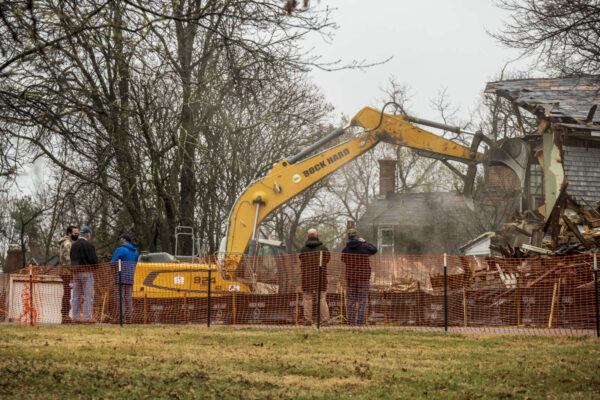A recent survey of Arlingtonians found a majority say the county needs to be more aggressive about preserving historic buildings, monuments and resources from demolition.
Engagement in the survey, administered in 2021, was three times higher than engagement in a similar survey distributed two years ago, before the loss last year of two historic homes — the Febrey-Lothrop House and the Victorian Fellows-McGrath House — to make room for new housing.
The tripling, however, did not result in a more diverse group of respondents. More than 80% of respondents were some combination of white, homeowners and 45 years old and up.
The most recent Historic Preservation feedback form response pool is somehow even more white and more homeowner-y than the last one. This seems indistinguishable from a CivFed meeting. pic.twitter.com/JI16BJqrlY
— Chris Slatt (@alongthepike) March 24, 2022
The survey is part of a county effort to update its master plan governing historic preservation, with a new focus on equity and inclusion, says Department of Community Planning, Housing and Development spokeswoman Rachel LaPiana.
Adopted in and unchanged since 2006, the update — if adopted by the County Board by the end of 2022 — will direct the historic preservation priorities and programs for the next decade, she said.
Many respondents said the county should be highlighting century-old properties, historic neighborhoods, archaeological sites and resources connected to Arlington’s immigrant, African American and Native American communities. Some railed against the county and the plan for not preserving sites like the Febrey-Lothrop House, while a few said such teardowns are necessary to make room for more housing and affordable units.
The survey asked broad questions to understand what residents value, with questions like “what stories, traditions, places, buildings, and/or communities are important to you?”
But for some civically engaged Arlington residents, the demographics of respondents were more interesting. They say this survey yielded detailed feedback from passionate individuals but did not reveal how the broader community values historic preservation.
The problem, per Dave Schutz — a civically engaged resident and prolific ARLnow commenter — is how the survey is advertised and where. His oft-repeated remark about community engagement in Arlington: “You ask twelve guys in Speedos whether we should build [the Long Bridge Aquatics Center], you will get a twelve to zip vote yes.”
Schutz suggested the county keep track of how respondents hear of the survey, so they know whose perspectives are being captured.
“I might require that surveys… contain an identifier so that the people tabulating results could see which ones had been filled out by people who were notified through the, say, Arlington Historical Society website and which by people notified through the ‘Engulf and Destroy Developers Mwa-ha-ha website,’ the County Board website — and if the opinion tendencies were wildly different, flag it for the decision makers that that was so.”
Joan Fitzgerald, a local resident who works in surveying populations, says county survey questions are often worded to confirm the biases of the survey writers, while the questions can be jargon-dense.
“County survey questions are often confusing, and participants often need a strong background in the topic to even understand what’s being asked,” said Fitzgerald, who sits on the development oversight committee for the Ashton Heights Civic Association.
That said, responses from people who understand the jargon are valuable when the county is hammering out policy details, argues Chris Slatt, a transportation advocate who highlighted the lopsided demographic response to the survey via Twitter.
“The folks who are passionate about the issue often have some specialized knowledge, a deeper understanding, and a willingness to put in the time to come up to speed on a complex topic,” he said. “When this planning process gets down to ‘How do we achieve our goals?’ I hope the folks who are super passionate about historic preservation are knee-deep in the implementation details and haggling over tax credits and zoning ordinance details.”
But to answer the more foundational, basic questions, Slatt says staff have to meet people where they are.
“You have to go to them, not ask them to come to you. You have to print out a stack of paper forms and grab some clipboards and go stand in front of grocery stores, schools, or in parks,” he said. “This is absolutely achievable now, and it was achievable during the pandemic as well.”
That is the county’s plan, says LaPiana. Between 2020 and 2021, the county administered three online feedback forms, convened four small focus groups and held three in-person events.
Now, staff will hold a series of in-person community events, attend events around Arlington and distribute a fourth online engagement survey.
“We are working with our partners to seek input from a diverse audience as we move through this process — and we appreciate any and all support from the community in helping to spread the word. Our goal is to highlight all communities, races, ethnicities, and groups by preserving resources key to those communities and highlighting their histories and stories,” she said.


